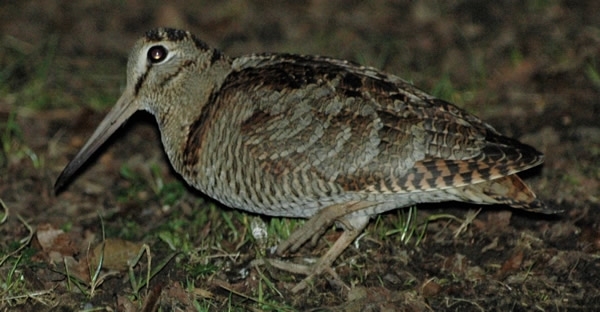
By Andrew Hoodless, Head of Wetland Research
The woodcock is adapted for feeding on soil invertebrates (mainly earthworms) and requires conditions in which it can probe for its food. It is forced off its breeding grounds in Scandinavia, Finland, the Baltic States and Russia by the onset of cold weather in autumn and migrates to milder wintering areas in southern and western Europe, including Britain, Ireland, France, Spain and Italy.
As with many other birds, the woodcock then faces a daily trade-off during the winter: carry too little fat and it risks starving, carry too much fat and it reduces its ability to escape from predators. However, severe winter weather can result in the rapid depletion of the energy reserves, sometimes leading to death if adverse conditions persist for more than a few days.
Corpses of starved woodcock have been reported in prolonged spells of unusually cold weather, but details of when woodcock start to be impacted and how long they are able to survive under different conditions are lacking.
Following discussion with shooters who sought guidance on best practice during cold weather, we thought it would be timely to assess the suitability of current measures for protecting woodcock and draw up some advice.
Our study
The aim of our study was to examine variation in energy reserves, and hence the potential fasting endurance or escape flight distance, of woodcock. Because earthworms are so abundant and widespread, we hypothesized that woodcock should be able to regulate their energy reserves efficiently until weather conditions result in the worms remaining too deep to be accessible or in woodcock being unable to probe the soil.
We dissected a sample of 221 birds from shoots to examine individual variation in fat stores and the relationship between fat levels and body weight. In collaboration with Owen Williams of the Woodcock Network, we then used weights from woodcock captured at our regular ringing sites in Hampshire and mid-Wales (1689 captures during 2010/11-2015/16) to assess changes in energy levels in relation to weather and during cold spells.
The findings
We found that woodcock are able to store large amounts of energy as fat, with weights ranging from 240 g in birds carrying little fat to 390 g in birds with maximum fat loads. In mid-winter, woodcock increased their energy reserves as night air temperature dropped, even below 0°C, provided the ground thawed during the day.
Once permanently frozen conditions set in, however, our data suggest that there is the potential for woodcock to starve to death within a week. In the event of a cold spell in Britain, woodcock could, on average, make escape flights of 860 km or withstand frozen conditions without feeding for six days.
In Britain, voluntary restraint in the shooting of wildfowl and waders is recommended after seven consecutive days of frozen conditions are recorded at more than half of a network of 25 coastal meteorological stations, although statutory suspension does not come into force until day 15.
A ‘Protection Order’ of 14 days is then enforced, although it can be revised after seven days. Since the mean fasting endurance of woodcock is six days, there is the potential for substantial mortality before the triggering of ‘voluntary restraint’ or the statutory suspension of shooting if weather conditions result in continuous frozen ground. In reality, many birds are likely to fly south and west, where possible, to escape the freezing conditions and may be able to find unfrozen ground to feed.
However, they will then have expended some of their energy reserves and may be at greater predation risk in an unfamiliar landscape. They should therefore also be protected in regions experiencing less severe conditions, that afford refuge, for as long as restrictions are imposed in areas with frozen conditions.
There is currently no alert within the British cold-weather shooting policy for conditions leading to frozen ground inland. Indeed, there is no common approach between countries within the wintering range of the woodcock to cold weather shooting restrictions. Although the incidence of cold spells likely to prevent woodcock from feeding is low, improved alerts could afford woodcock better protection when such conditions materialise.
Our advice for shooters
We suggest that shooters across Europe should adopt a more cautious approach to shooting woodcock in cold weather and should stop after four days of frozen conditions and allow the birds at least seven days to recover after the end of the cold period before shooting recommences.
We think statutory authorities across Europe should adopt a consistent approach and consider a regional system for an alert advising cessation of woodcock shooting after four days of frozen conditions across an appropriate range of inland sites. Shooting organizations and hunters’ clubs could play an active role, especially through social media, in quickly raising awareness of adverse conditions and promoting good practice.
This blog is based on an article Regulation of body reserves in a hunted wader: Implications for cold-weather shooting restrictions, recently published in the Journal of Applied Ecology.
Please support our vital woodcock research